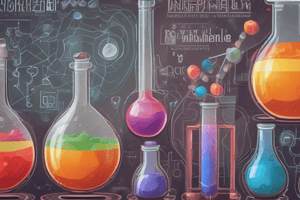Podcast
Questions and Answers
Which statement accurately describes a difference between elements, compounds, and mixtures?
Which statement accurately describes a difference between elements, compounds, and mixtures?
- Mixtures have a fixed composition, while compounds do not.
- Compounds are made up of two or more types of atoms bonded together. (correct)
- Elements can be broken down into simpler substances.
- Elements and compounds are both homogeneous mixtures.
What is the correct mass and charge of a proton?
What is the correct mass and charge of a proton?
- 1 amu, negative charge
- 0 amu, positive charge
- 1 amu, no charge
- 1 amu, positive charge (correct)
Which of the following statements best defines isotopes?
Which of the following statements best defines isotopes?
- Atoms with the same number of protons but different numbers of neutrons. (correct)
- Atoms with the same number of neutrons but different numbers of protons.
- Atoms that have gained or lost electrons.
- Atoms that form only ionic bonds.
In an atom with an atomic number of 12 and a mass number of 24, how many neutrons does it have?
In an atom with an atomic number of 12 and a mass number of 24, how many neutrons does it have?
Which statement correctly describes the formation of ions?
Which statement correctly describes the formation of ions?
What characteristic differentiates cations from anions?
What characteristic differentiates cations from anions?
How does the arrangement of electrons in an atom relate to its position in the periodic table?
How does the arrangement of electrons in an atom relate to its position in the periodic table?
What is the mass number of an atom if it contains 20 protons and 21 neutrons?
What is the mass number of an atom if it contains 20 protons and 21 neutrons?
Which of the following statements correctly describes isotopes?
Which of the following statements correctly describes isotopes?
How can the charge of an ion be determined from its atomic composition?
How can the charge of an ion be determined from its atomic composition?
Flashcards
Subatomic Particles
Subatomic Particles
The tiny particles that make up an atom: protons, neutrons, and electrons.
Isotopes
Isotopes
Atoms of the same element with different numbers of neutrons.
Atomic Number
Atomic Number
The number of protons in an atom's nucleus.
Ionic Compound Formation
Ionic Compound Formation
Signup and view all the flashcards
Valence Electrons
Valence Electrons
Signup and view all the flashcards
Subatomic Particle Types
Subatomic Particle Types
Signup and view all the flashcards
Element vs. Compound
Element vs. Compound
Signup and view all the flashcards
Isotope Definition
Isotope Definition
Signup and view all the flashcards
Atomic Mass vs. Atomic Number
Atomic Mass vs. Atomic Number
Signup and view all the flashcards
Ion Formation
Ion Formation
Signup and view all the flashcards
Study Notes
Comparing Elements, Compounds, and Mixtures
- Elements are pure substances with one type of atom.
- Compounds are pure substances with two or more different types of atoms bonded together.
- Mixtures are combinations of two or more substances that are not chemically bonded.
Subatomic Particles
- Atoms are made up of three subatomic particles: protons, neutrons, and electrons.
- Protons have a positive charge and are located in the nucleus.
- Neutrons have no charge and are located in the nucleus.
- Electrons have a negative charge and orbit the nucleus.
Isotopes
- Isotopes are atoms of the same element with different numbers of neutrons.
- The number of protons is the same, but the number of neutrons varies.
- Isotopic symbols display the element symbol, mass number, and atomic number.
Mass and Atomic Number
- Atomic number is the number of protons in an atom; it defines the element.
- Mass number is the total number of protons and neutrons in an atom.
- Using atomic number and mass number, the number of neutrons in an atom can be calculated.
Electron Arrangement
- Electrons orbit the nucleus in specific energy levels called electron shells.
- The arrangement of electrons determines the chemical properties of an element.
- Valence electrons are electrons in the outermost shell and influence how an element will bond with others.
Periodic Table
- The periodic table organizes elements based on their properties.
- The number of valence electrons correlates with the element's group on the periodic table.
Ions
- Ions are atoms that have lost or gained electrons, giving them a net positive or negative charge.
- Metals lose electrons to form positive ions called cations.
- Nonmetals gain electrons to form negative ions called anions.
- Ions form when atoms need to fulfill a stable octet rule or other rules.
Electron Shell Diagrams
- Electron shell diagrams visually represent the arrangement of electrons in different energy levels around the nucleus.
Calculating Ion Charge
- The charge of an ion can be calculated by comparing the number of protons and electrons.
Ionic Compound Formation
- Ionic compounds form when metals react with nonmetals.
- The metal loses electrons, forming a positive cation, and the nonmetal gains electrons, forming a negative anion.
- The electrostatic attraction between these oppositely charged ions forms the ionic bond.
Chemical Formulae
- Chemical formulas represent the composition of ionic compounds.
Studying That Suits You
Use AI to generate personalized quizzes and flashcards to suit your learning preferences.




